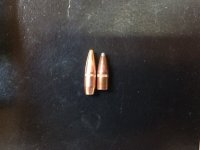Ballistic147
Member
- Joined
- Feb 24, 2015
- Messages
- 713
- Reaction score
- 719
I've been looking for an economical 62gr plinking bullet for loading 223/5.56. Last week MidSouth sent out an email that they now had Hornady 62gr HPBT's in stock that are decently priced. Apparently this is either custom made for MS or a brand new offering from Hornady. Anyway, I picked up 500 of them to try out.
Now being a reloading beginner I understand that how deep the bullet extends into the case will effect pressure. This new bullet when seated to the cannelure will be .100" deeper than what I've used in the past. None of the manuals list this particular bullet and none list the actual dimensions of other bullets to give me a comparison. Yes, I know to start low and work up but how much difference does .100" more bullet in the case increase the pressure? Is there any type of resource out there that lists the dimensions of various brands of bullets?
Below is a photo of the bullet I've been using beside of the new bullet. I've also used a couple others but they were dimensionally the same from base to cannelure.
Now being a reloading beginner I understand that how deep the bullet extends into the case will effect pressure. This new bullet when seated to the cannelure will be .100" deeper than what I've used in the past. None of the manuals list this particular bullet and none list the actual dimensions of other bullets to give me a comparison. Yes, I know to start low and work up but how much difference does .100" more bullet in the case increase the pressure? Is there any type of resource out there that lists the dimensions of various brands of bullets?
Below is a photo of the bullet I've been using beside of the new bullet. I've also used a couple others but they were dimensionally the same from base to cannelure.

